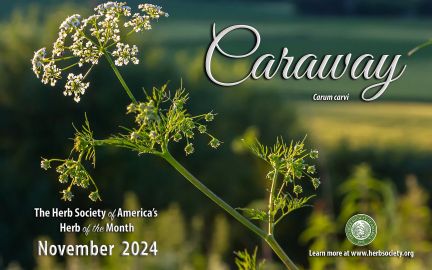  |
The mission statement of the Herb Society of America is to "promote the knowledge, use and delight of herbs through educational programs, research and sharing the experience of its members with the community".
The Society is committed to protecting our global environment for the health and well-being of humankind and all growing things. We encourage gardeners to practice environmentally sound horticulture.
The Motto of the Society is taken from the herbalist, John Parkinson: "For Use and Delight"
|
Attention Members
We have a new permanent meeting place:
The Hill Country Unit meets the third Wednesday of the month, September through May, at 9:30 a.m.
at the Craft Lab in the Wimberley Village Library, 400 FM 2325, Wimberley, TX.
|
|
Program Info
NOVEMBER Meeting: "Herbal Gift Making"
When: November 20, 2024
9:30am - Herbal Treats
10am - Discussion / Meeting
Where: Craft Lab at the Wimberley Village Library
400 FM2325, Wimberley, TX 78676
The Unit's Program Director,
Kathy Boyle will demonstrate how to make decorative gifts, including an herbal wreath and decorating a Fall candle holder and participants will make items to take home.
Contact Lisa Valentine for membership or attendance information.
RSVP to Lisa Valentine at valentine_lisa@msn.com
2024-2025 Calendar of Events
|
|
Herb of the Month - November 2024
(Click on the image below for recipes)
Caraway (Carum carvi)
 Caraway is a biennial and related to dill, cumin, fennel and anise which also produce aromatic fruits, commonly called seeds. Caraway is a biennial and related to dill, cumin, fennel and anise which also produce aromatic fruits, commonly called seeds.
 The caraway plant is 18-24" tall with delicate, white to pink, umbel-shaped flowers and finely dissected, feathery leaves. It flowers in the spring of the second year of growth. The caraway plant is 18-24" tall with delicate, white to pink, umbel-shaped flowers and finely dissected, feathery leaves. It flowers in the spring of the second year of growth.
 The common name seems to come from the Arabic name for the seed karawya, but the etymology is unclear. It has had many different names in different languages, including in Latin, Greek, Sanskrit and Arabic. The common name seems to come from the Arabic name for the seed karawya, but the etymology is unclear. It has had many different names in different languages, including in Latin, Greek, Sanskrit and Arabic.
 The “seeds” are actually half of the caraway fruit, which splits down the middle and strongly resembles cumin seeds. They have a distinctive fragrance when crushed. The “seeds” are actually half of the caraway fruit, which splits down the middle and strongly resembles cumin seeds. They have a distinctive fragrance when crushed.
 Caraway has been used for 5000 years, dating back to the Mesolithic era. It was used in the burial of ancient Egyptians. Early Greek and Roman used it in cooking and for medicinal purposes. Caraway has been used for 5000 years, dating back to the Mesolithic era. It was used in the burial of ancient Egyptians. Early Greek and Roman used it in cooking and for medicinal purposes.
 Turmeric is used fresh or can be frozen and is prepared by slicing, chopping, or grating. Turmeric is used fresh or can be frozen and is prepared by slicing, chopping, or grating.
 Caraway has been used historically to aid digestive disorders and was added to breads, cakes and baked fruit in the Middle Ages for that purpose. Caraway has been used historically to aid digestive disorders and was added to breads, cakes and baked fruit in the Middle Ages for that purpose.
 Love potions included caraway as the ingredient that kept couples faithful and was given to homing pigeons to encourage their return home as well. Love potions included caraway as the ingredient that kept couples faithful and was given to homing pigeons to encourage their return home as well.
 Caraway flavors sausage, sauerkraut, soups and stews, cheeses, breads, cakes and cooked fruit. Caraway flavors sausage, sauerkraut, soups and stews, cheeses, breads, cakes and cooked fruit.
 Seeds coated with sugar are used for comfits and to decorate cakes and cookies. Seeds coated with sugar are used for comfits and to decorate cakes and cookies.
 Kümmel is a caraway-flavored liqueur. Caraway oil also flavors aquavit, gin, and schnapps. Kümmel is a caraway-flavored liqueur. Caraway oil also flavors aquavit, gin, and schnapps.
 Caraway oil also is used commercially in mouthwashes, toothpaste, chewing gums and is used in perfumery. Caraway oil also is used commercially in mouthwashes, toothpaste, chewing gums and is used in perfumery.
 Caraway seeds are best harvested in the early morning when the fragile seed heads are moist with dew. This prevents the seeds from shattering before they are collected. The seed heads are thrashed after a drying process. Caraway seeds are best harvested in the early morning when the fragile seed heads are moist with dew. This prevents the seeds from shattering before they are collected. The seed heads are thrashed after a drying process.
|
|
Web Links of Interest:
 Herb Society of America Herb Society of America
 Austin Herb Society Austin Herb Society
 North Texas Herb Society North Texas Herb Society
 South Texas Herb Society South Texas Herb Society
 San Antonio Herb Society San Antonio Herb Society
Member Benefits:
 Free or discounted admissions to participating gardens and arboreta nationwide though AHS Reciprocal Garden Program Free or discounted admissions to participating gardens and arboreta nationwide though AHS Reciprocal Garden Program
 Specialized district and annual meetings Specialized district and annual meetings
 Connection to fellow herb enthusiasts through the exclusive, online HSA Membership Directory Connection to fellow herb enthusiasts through the exclusive, online HSA Membership Directory
 Subscription to the annual journal THE HERBARIST as well as national and district newsletters Subscription to the annual journal THE HERBARIST as well as national and district newsletters
 Admission to the members-only section of HSA's website, which includes special educational programs Admission to the members-only section of HSA's website, which includes special educational programs
|
|
|
|

